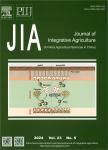Cotton maturity and responses to harvest aids following chemical topping with mepiquat chloride during bloom period
Cotton maturity and responses to harvest aids following chemical topping with mepiquat chloride during bloom period作者机构:Engineering Research Center of Plant Growth RegulatorMinistry of Education/College of Agronomy and BiotechnologyChina Agricultural UniversityBeijing 100193P.R.China Department of Soil ScienceFaculty of AgricultureForestry and Wildlife Resources ManagementUniversity of CalabarCalabar 540271Nigeria Hebei Cottonseed Engineering Technology Research CenterHejian 062450P.R.China
出 版 物:《Journal of Integrative Agriculture》 (农业科学学报(英文版))
年 卷 期:2022年第21卷第9期
页 面:2577-2587页
核心收录:
基 金:supported by the National Key Research and Development Program of China(2018YFD0100306) the China Agriculture Research System of MOF and MARA(CARS-15-16)
主 题:cotton mepiquat chloride thidiazuron ethephon defoliation maturity
摘 要:Early maturity, complete defoliation and boll opening are essential for the efficient machine harvesting of cotton. Chemical topping, involving one extra application of mepiquat chloride(MC) in addition to its traditional multipleapplication strategy, may be able to replace manual topping. However, it is not known whether this chemical topping technique will influence maturity or cotton responses to harvest aids. In this 2-yr field study, we determined the effects of the timing of chemical topping using various rates of MC on boll opening percentage(BOP) before application of harvest aids(50% thidiazuron··ethephon suspension concentrate, referred to as TE), and the defoliation percentage(DP) and BOP 14 days after TE application. The results indicated that late chemical topping(near the physiological cutout, when the nodes above white flower is equal to 5.0) significantly decreased BOP before TE by 5.9–11.2% compared with early(at peak bloom) or middle(seven days after peak bloom) treatments in 2019, which was a relatively normal year based on crop condition. Also, a high MC rate(270 g ha) showed a significantly lower(22.0%) BOP before TE than low(90 g ha) or medium(180 g ha) rates. In 2020, which was characterized by stronger vegetative growth in the late season, the late chemical topping reduced the number of leaves before TE application relative to early or middle treatments, but had lower DP(23.2–27.2%) 14 days after TE application. The high MC rate showed a leaf count before TE application that was similar to the low and medium rates, but it showed the most leaves after TE and much lower(15.0–21.7%) DP in 2020. These results suggest that late timing of chemical topping and a high MC rate decreased the sensitivity of leaves to harvest aids. Further analysis indicated that the late chemical topping mainly affected the leaf drop from the mainstem and fruiting branches where the late regrowth occurred, and the high MC rate reduced leaf shedding from these parts and



